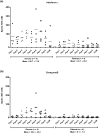Identification of Four-Jointed Box 1 (FJX1)-Specific Peptides for Immunotherapy of Nasopharyngeal Carcinoma
- PMID: 26536470
- PMCID: PMC4633155
- DOI: 10.1371/journal.pone.0130464
Identification of Four-Jointed Box 1 (FJX1)-Specific Peptides for Immunotherapy of Nasopharyngeal Carcinoma
Abstract
Nasopharyngeal carcinoma (NPC) is highly prevalent in South East Asia and China. The poor outcome is due to late presentation, recurrence, distant metastasis and limited therapeutic options. For improved treatment outcome, immunotherapeutic approaches focusing on dendritic and autologous cytotoxic T-cell based therapies have been developed, but cost and infrastructure remain barriers for implementing these in low-resource settings. As our prior observations had found that four-jointed box 1 (FJX1), a tumor antigen, is overexpressed in NPCs, we investigated if short 9-20 amino acid sequence specific peptides matching to FJX1 requiring only intramuscular immunization to train host immune systems would be a better treatment option for this disease. Thus, we designed 8 FJX1-specific peptides and implemented an assay system to first, assess the binding of these peptides to HLA-A2 molecules on T2 cells. After, ELISPOT assays were used to determine the peptides immunogenicity and ability to induce potential cytotoxicity activity towards cancer cells. Also, T-cell proliferation assay was used to evaluate the potential of MHC class II peptides to stimulate the expansion of isolated T-cells. Our results demonstrate that these peptides are immunogenic and peptide stimulated T-cells were able to induce peptide-specific cytolytic activity specifically against FJX1-expressing cancer cells. In addition, we demonstrated that the MHC class II peptides were capable of inducing T-cell proliferation. Our results suggest that these peptides are capable of inducing specific cytotoxic cytokines secretion against FJX1-expressing cancer cells and serve as a potential vaccine-based therapy for NPC patients.
Conflict of interest statement
Figures






Similar articles
-
In vitro evaluation of dual-antigenic PV1 peptide vaccine in head and neck cancer patients.Hum Vaccin Immunother. 2019;15(1):167-178. doi: 10.1080/21645515.2018.1520584. Epub 2018 Oct 12. Hum Vaccin Immunother. 2019. PMID: 30193086 Free PMC article.
-
Whole-tumor-antigen-pulsed dendritic cells elicit cytotoxic T-cell response against pediatric nasopharyngeal carcinoma in vitro.Med Oncol. 2009;26(1):78-85. doi: 10.1007/s12032-008-9093-8. Epub 2008 Sep 20. Med Oncol. 2009. PMID: 18810669
-
Functional assays of HLA A2-restricted epitope variant of latent membrane protein 1 (LMP-1) of Epstein-Barr virus in nasopharyngeal carcinoma of Southern China and Taiwan.J Biomed Sci. 2005 Dec;12(6):925-36. doi: 10.1007/s11373-005-9017-y. Epub 2005 Nov 24. J Biomed Sci. 2005. PMID: 16307312
-
Peptide epitope identification for tumor-reactive CD4 T cells.Curr Opin Immunol. 2008 Apr;20(2):221-7. doi: 10.1016/j.coi.2008.04.011. Epub 2008 May 20. Curr Opin Immunol. 2008. PMID: 18499419 Free PMC article. Review.
-
Identification of peptides for immunotherapy of cancer. It is worth the effort.Crit Rev Immunol. 1998;18(1-2):7-27. doi: 10.1615/critrevimmunol.v18.i1-2.30. Crit Rev Immunol. 1998. PMID: 9419444 Review.
Cited by
-
In vitro evaluation of dual-antigenic PV1 peptide vaccine in head and neck cancer patients.Hum Vaccin Immunother. 2019;15(1):167-178. doi: 10.1080/21645515.2018.1520584. Epub 2018 Oct 12. Hum Vaccin Immunother. 2019. PMID: 30193086 Free PMC article.
-
DNA Vaccines Targeting Novel Cancer-Associated Antigens Frequently Expressed in Head and Neck Cancer Enhance the Efficacy of Checkpoint Inhibitor.Front Immunol. 2021 Oct 18;12:763086. doi: 10.3389/fimmu.2021.763086. eCollection 2021. Front Immunol. 2021. PMID: 34733290 Free PMC article.
-
The ABCs of the atypical Fam20 secretory pathway kinases.J Biol Chem. 2021 Jan-Jun;296:100267. doi: 10.1016/j.jbc.2021.100267. Epub 2021 Jan 8. J Biol Chem. 2021. PMID: 33759783 Free PMC article. Review.
-
Identification of important invasion and proliferation related genes in adrenocortical carcinoma.Med Oncol. 2019 Jul 18;36(9):73. doi: 10.1007/s12032-019-1296-7. Med Oncol. 2019. PMID: 31321566
-
An Oncogenic Role for Four-Jointed Box 1 (FJX1) in Nasopharyngeal Carcinoma.Dis Markers. 2019 May 19;2019:3857853. doi: 10.1155/2019/3857853. eCollection 2019. Dis Markers. 2019. PMID: 31236144 Free PMC article.
References
-
- Titcomb CP Jr. High incidence of nasopharyngeal carcinoma in Asia. J Insur Med. 2001;33(3):235–8. - PubMed
-
- Omar ZA, Tamin NSI, editors. National Cancer Registry, Report 2007: Ministry of Health Malaysia; 2011.
-
- Devi BC, Pisani P, Tang TS, Parkin DM. High incidence of nasopharyngeal carcinoma in native people of Sarawak, Borneo Island. Cancer Epidemiol Biomarkers Prev. 2004. March;13(3):482–6. - PubMed
Publication types
MeSH terms
Substances
LinkOut - more resources
Full Text Sources
Other Literature Sources
Research Materials

